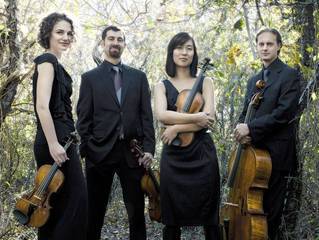|
Back
Bells, harmonics and inspiration New York
Grace Rainey Rogers Auditorium
05/11/2017 -
Pierre Jalbert: Canticle (String Quartet No. 6) (New York Premiere)
Johannes Brahms: Clarinet Quintet, Opus 115
Todd Palmer (Clarinet), Chiara String Quartet: Rebecca Fischer, Hyeyung Yoon (Violins), Jonah Siruta (Viola), Gregory Beaver (Cello)

Chiara Quartet (© Lisa-Marie Mazzucco)
One might rightfully be suspicious of a string quartet whose first movement is titled “Eternal, Timeless”. But not owning a timepiece, I had no way to prove whether Pierre Jalbert’s Sixth String Quartet last night fulfilled its curious promise of perpetuity.
And anyhow, so many interesting things were happening in all seven movements of the work, that there was no time (literally) to worry about that.
The Chiara String Quartet were the worthy performers of this piece, as well as the Brahms Clarinet Quintet, and their venue, as before, was smack in the middle of the Met Museum’s Egyptian exhibits. No matter what the status of artists performing in the Grace Rainey Rogers Auditorium, the notion that intermissions offer chances to delve into arts from Pharaonic times through the Ptolemies make visits here doubly entrancing.
The Chiara String Quartet is a regular performer here, for during 2015-2016, they were quartet-in-residence. Not that they are antiquated or antediluvian or stuffed like mummies. But because they usually do exemplify their name, which means “light” or “lucent” or “pure”. The last time I heard them, they were playing Brahms, whose chamber music doesn’t always exemplifies these modifiers. But they made a good show of it, for their experienced expertise and enthusiasm puts them in worldwide class.
This hour-long concert again ended with Brahms. But before that was Mr. Jalbert’s offering, and for those who are allergic to string quartets, he added some other instruments. The two violinists added crotales–a row of tiny cymbals on a board–to their strings, as well as glass bows, which gave a different color. Cellist Gregory Beaver added the sounds of harmonics way up on the highest end of the instrument, making a sound somewhere between a theremin and a ghoulish whistle.
Still, Mr. Jalbert was never creating a novelty piece in a work he called Canticle (for the crotale sound). The seven short movements were each as inspired as the titles. “Intense, dramatic”, or “Ethereal” or “Driving” or “Soulful, mysterious.”
The music didn’t always fit the pictures, which was fine. The second “intense, dramatic” movement was like some of Elliott Carter’s late string quartet music, the instruments fighting with each over for precedence, the different sounds crowding each other out to win the argument, but all in good fun after the reverent religious-style beginning. In that initial scurry of sounds, violinist Rebecca Fischer played a few measures of a beautiful tune. And oh, how I wish she had modified, continued it. (Wait, though!)
Mr. Jalbert’s sense of color continued in a pizzicato-style third movement, and this went into another section where that cello played harmonic top notes which seemed to drown out the rest of the players.
For the finale, Mr. Jalbert in this so diverse, so variegated, so aurally inspired work, offered a surprise. Ms. Fischer’s original few lyrical measures came back again, longer, more beautiful than before, with an avian sense of continuity.
One was satisfied, and the final “soulful mysterious” movement, described as a coda by the composer had a long drawn-out, faintly liturgical ending. One thought of Mahler’s Abschied from his song cycle. For this was indeed the “Amen” or farewell to an intriguing work which–unlike so many other contemporary compositions–never outwore its welcome. Mr. Jalbert said what he had to say (which was a lot!) and then moved on. Altogether a work worth hearing again and again.
The Clarinet Quintet had a fine soloist in Todd Palmer. He gave what is unthinkable. A humorous introduction about...about Johannes Brahms??
The piece itself is often sombre, one of the last written by the composer. But it is also, like the preceding Jalbert, complex, inspired and filled with feeling.
First, compliments must go both to Palmer, the Chiara String Quartet and the designer of the Grace Rainey Rogers Auditorium for such a balance of sounds. The four string players and the clarinetist were listening to each other, they produced transparent textures for all five players. And in the second movement, where Mr. Palmer had all the cadenza-like solos, they allowed him full rein to show his effortless technique.
I have heard the work innumerable times, and little was singular here. The autumnal sounds, the intricacies, the “conversations” were given their due. At the end, the players were offered our utmost respect...if not love.
Perhaps respect is all that is necessary for the work. Or perhaps my emotions were exhausted by the feelings and idiosyncratic fascination with Mr. Jalbert’s Canticles.
Harry Rolnck
|